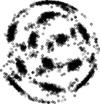You are here: Foswiki>Cosmo Web>GrassmannCosmoFun2009>GrassCosmoFun09Wed (29 Oct 2009, BoudRoukema)Edit Attach
<< Cosmo
main page: GrassmannCosmoFun2009 These are just rough notes - feel free to correct them, add links, etc. from the Grassmann ian Conference in Fundamental Cosmology (Grasscosmofun'09). These are not official proceedings. The speakers might even disagree that they said anything even vaguely related to what are in these online notes! Don't say you weren't warned.
main page: GrassmannCosmoFun2009 These are just rough notes - feel free to correct them, add links, etc. from the Grassmann ian Conference in Fundamental Cosmology (Grasscosmofun'09). These are not official proceedings. The speakers might even disagree that they said anything even vaguely related to what are in these online notes! Don't say you weren't warned.
Wed 16 Sep 2009 - Lotte + Heller
Renate LOTTE - CDT (Causal Dynamical Triangulation) QG
-
- "euclidean" path integrals give different (wrong) results compared to lorentzian path integrals - causality is necessary for doing this properly
- Wick rotation
- trying to build up a 4D model
- euclideanised: get phases with Hausdorff dimension infinity or 2
- lorentzian: 3 phases - "A, B, C" - phase C is the cosmologically interesting phase
- figure "dynamically generated 4-d quantum universe, obtained from a causal path integral"
- results:
- casuality is not emergent, must be assumed as microcausality on each spacetime history
- time is not emergent, must be assumed
- "CDT is the only theory of QG where a classical extended geometry is generated from Planck-scale ecitations"
- e.g. hep-th/0505113 with Jurkiewicz, ...
- topology and dimensionality become dynamical in QT; can happen because
- short-scale fluctuations are large
- we are taking a nontrivial continuum limit
- "contribution from 'microstates' is crucial for obtaining de Sitter space"
- thesis: "there is a unique interacting quantum (field) theory of spacetime geometry in 4D, which has GR as its classical limit"
- if thesis true, then CDT approach has a good chance of finding this
- Review papers on this: ArXiv:0711.0273, HepTh:0604212, HepTh:0509010 (hep-th/0604212, hep-th/0509010)
- http://www.phys.uu.nl/~loll
- "euclidean" path integrals give different (wrong) results compared to lorentzian path integrals - causality is necessary for doing this properly
Michal HELLER - noncommutative Friedman cosmology model
-
- generation of matter; singularities
- transformation groupoid:
- \Gamma = E \times G (G = Lorentz group); \gamma \in \Gamma are pairs (p,g)
- -> E = frame bundle
- -> M = space-time
- but considers Lorentz transformations as more fundamental than space-time
- \Gamma_1 = E \times E, \gamma = (p_1, p_2) = pair groupoid
- \Gamma_1 and \Gamma are isomorphic
- algebra

- compact support, convolution is multiplication
-

- Z(A) = 0 - the center of the group is zero
- "outer centre" defined

- \alpha: Z \times A \rightarrow A
-

- info on GR + QG contained in differential algebra (A, DerA)
-

- V_1 "horizontal" - lifted from M with the help of the connection
- V_2 "vertical" - projecting to zero on M
- V_3 "InnA" = {ad a: a \in A}
- V_1 circplus V_2 - gravitational sector
- V_3 - quantum sector
-
- gravitational sector
- 3. universe
- M = (0,T) \times S^3
- E = M \times R
- G = ...
- \Gamma = ...
- A = ...
- Einstein equation now becomes eigenvalue type problem
-

- eigenvalues \tau_B and \tau_h give standard stress-energy tensor
- \tau_Q = 1/2 \tau_B + 3/2 \tau_h
- \tau_Q = 4\pi G\rho - dust
- \tau_Q = 0 - radiation
-
| I | Attachment | Action | Size | Date | Who | Comment |
|---|---|---|---|---|---|---|
| |
5eb09958d3625f10e91e251e7f1d3fe0.png | manage | 584 bytes | 17 Sep 2009 - 08:21 | UnknownUser | |
| |
7c3d29c567c19227704a9e40a5c28ba0.png | manage | 625 bytes | 17 Sep 2009 - 08:21 | UnknownUser | |
| |
8b6bbedd2a74b0e7f0f8353302c15671.png | manage | 895 bytes | 17 Sep 2009 - 08:21 | UnknownUser | |
| |
cee01368113c8ddc62f1aff92dfe25fd.png | manage | 962 bytes | 17 Sep 2009 - 08:21 | UnknownUser | |
| |
dc9b54032e82e016c1d68cc4abab10b8.png | manage | 1 K | 17 Sep 2009 - 08:21 | UnknownUser | |
| |
e796c4b68be8d750363a9773d18a82af.png | manage | 570 bytes | 17 Sep 2009 - 08:21 | UnknownUser |
Edit | Attach | Print version | History: r2 < r1 | Backlinks | View wiki text | More topic actions
Topic revision: r2 - 29 Oct 2009, BoudRoukema
 Copyright © by the contributing authors. All material on this collaboration platform is the property of the contributing authors.
Copyright © by the contributing authors. All material on this collaboration platform is the property of the contributing authors. Ideas, requests, problems regarding Foswiki? Send feedback


